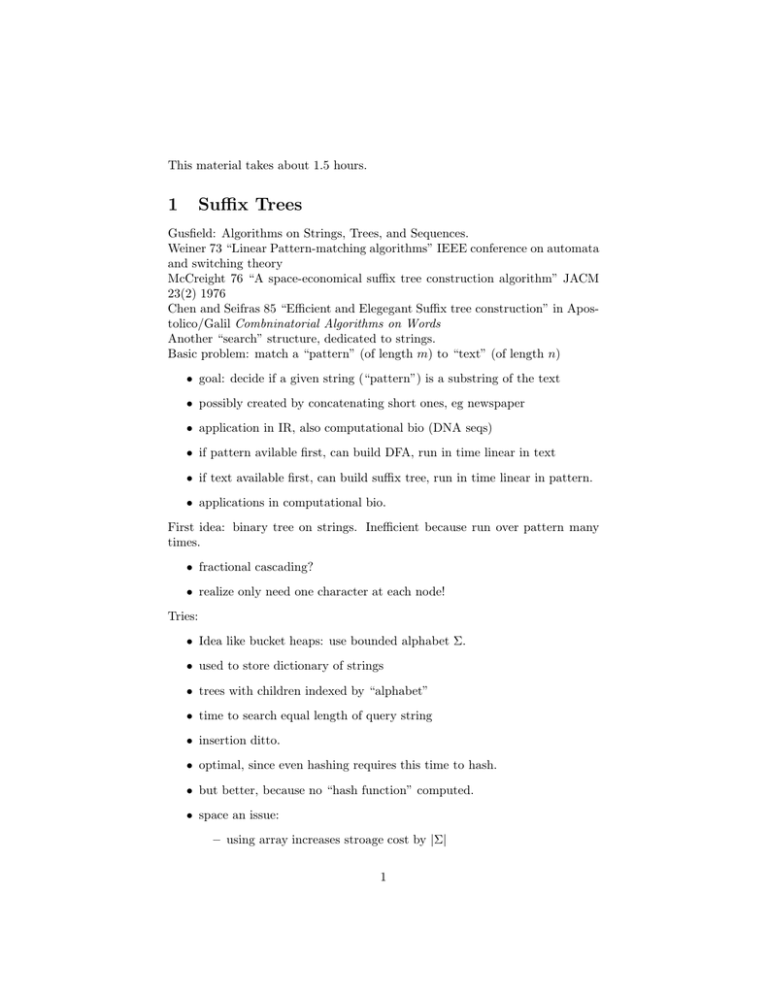1
advertisement

This material takes about 1.5 hours. 1 Suffix Trees Gusfield: Algorithms on Strings, Trees, and Sequences. Weiner 73 “Linear Pattern-matching algorithms” IEEE conference on automata and switching theory McCreight 76 “A space-economical suffix tree construction algorithm” JACM 23(2) 1976 Chen and Seifras 85 “Efficient and Elegegant Suffix tree construction” in Apostolico/Galil Combninatorial Algorithms on Words Another “search” structure, dedicated to strings. Basic problem: match a “pattern” (of length m) to “text” (of length n) • goal: decide if a given string (“pattern”) is a substring of the text • possibly created by concatenating short ones, eg newspaper • application in IR, also computational bio (DNA seqs) • if pattern avilable first, can build DFA, run in time linear in text • if text available first, can build suffix tree, run in time linear in pattern. • applications in computational bio. First idea: binary tree on strings. Inefficient because run over pattern many times. • fractional cascading? • realize only need one character at each node! Tries: • Idea like bucket heaps: use bounded alphabet Σ. • used to store dictionary of strings • trees with children indexed by “alphabet” • time to search equal length of query string • insertion ditto. • optimal, since even hashing requires this time to hash. • but better, because no “hash function” computed. • space an issue: – using array increases stroage cost by |Σ| 1 – using binary tree on alphabet increases search time by log |Σ| – ok for “const alphabet” – if really fussy, could use hash-table at each node. • size in worst case: sum of word lengths (so pretty much solves “dictionary” problem. But what about substrings? • idea: trie of all n2 substrings • equivalent to trie of all n suffixes. • put “marker” at end, so no suffix contained in other (otherwise, some suffix can be an internal node, “hidden” by piece of other suffix) • means one leaf per suffix • Naive construction: insert each suffix • basic alg: – text a1 · · · an – define si = ai · · · an – for i = 1 to n – insert si • time, space O(n2 ) Better construction: • note trie size may be much smaller: aaaaaaa. • algorithm with time O(|T |) • idea: avoid repeated work by “memoizing” • also shades of finger search tree idea—use locality of reference • suppose just inserted aw • next insert is w • big prefix of w might already be in trie • avoid traversing: skip to end of prefix. Suffix links: • any node in trie corresponds to string • arrange for node corresp to ax to point at node corresp to x 2 • suppose just inserted aw. • walk up tree till find suffix link • follow link (puts you on path corresp to w) • walk down tree (adding nodes) to insert rest of w Memoizing: (save your work) • can add suffix link to every node we walked up • (since walked up end of aw, and are putting in w now). • charging scheme: charge traversal up a node to creation of suffix link • traversal up also covers (same length) traversal down • once node has suffix link, never passed up again • thus, total time spent going up/down equals number of suffix links • one suffix link per node, so time O(|T |) half hour up to here. Amortization key principles: • Lazy: don’t work till you must • If you must work, use your work to “simplify” data structure too • force user to spend lots of time to make you work • use charges to keep track of work—earn money from user activity, spend it to pay for excess work at certain times. Linear-size structure: • problem: maybe |T | is large (n2 ) • compress paths in suffix trie • path on letters ai · · · aj corresp to substring of text • replace by edge labelled by (i, j) (implicit nodes) • Example: tree on abab$ • gives tree where every node has indegree at least 2 • in such a tree, size is order number of leaves = O(n) • terminating $ char now very useful, since means each suffix is a node • Wait: didn’t save space; still need to store characters on edge! 3 • see if someone with prompting can figure out: characters on edge are substring of pattern, so just store start and end indices. Look in text to see characters. Search still works: • preserves invariant: at most one edge starting with given character leaves a node • so can store edges in array indexed by first character of edge. • walk down same as trie • called “slowfind” for later Construction: • obvious: build suffix trie, compress • drawback: may take n2 time and intermediate space • better: use original construction idea, work in compressed domain. • as before, insert suffixes in order s1 , . . . , sn • compressed tree of what inserted so far • to insert si , walk down tree • at some point, path diverges from what’s in tree • may force us to “break” an edge (show) • tack on one new edge for rest of string (cheap!) MacReight 1976 • use suffix link idea of up-link-down • problem: can’t suffix link every character, only explict nodes • want to work proportional to real nodes traversed • need to skip characters inside edges (since can’t pay for them) • introduced “fastfind” – idea: fast alg for descending tree if know string present in tree – just check first char on edge, then skip number of chars equal to edge “length” – may land you in middle of edge (specified offset) – cost of search: number of explicit nodes in path 4 – amortize: pay for with explicit-node suffix links Amortized Analysis: • suppose just inserted string aw • sitting on its leaf, which has parent • Parent is only node that was (possibly) created by insertion: – As soon as walk down preexisting tree falls of tree, create parent node and stop • invariant: every internal node except for parent of current leaf has suffix link to another explicit node • plausible? – i.e., is there an explicit node for that suffix link to point at? – suppose v was created as parent of sj leaf when it diverged from sk – (note this is only way nodes get created) – claim sj+1 and sk+1 diverge at suffix(v), creating another explicit node. – only problem if sk+1 not yet present – happens only if k is current suffix – only blocks parent of current leaf. • insertion step: – suppose just inserted si – consider parent pi and grandparent (parent of parent) gi of current node – gi to pi link has string w1 – pi to si link w2 – go up to grandparent – follow suffix link (exists by invariant) – fastfind w1 – claim: know w1 is present in tree! ∗ pi was created by si split from a previous edge (or preexisted) ∗ so aww1 was in tree before si inserted (prefix of earlier suffix) ∗ so ww1 is in tree after si inserted – create suffix link from pi (preserves invariant) – slowfind w2 (stopping when leave current tree) – break current edge if necessary (may land on preexisting node) 5 – add new edge for rest of w2 Analysis: • First, consider work to reach gi+1 • Mix of fastfind and slowfind, but no worse then cost of doing pure slowfind • This is it most |gi+1 | − |gi | + 1 (explain length notation) � • So total is O( |gi+1 | − |gi | + 1) = O(n) • Wait: maybe gi+1 − gi + 1 < 0, and I am cheating on sum? – Note si+1 is suffix of si – so gi suffix link must point at gi+1 or above – so |gi+1 | ≥ |gi | − 1 • Remaining cost: to reach pi+1 . – If get there during fastfind, costs at most one additional step – If get there during slowfind, means slowfind stopped at or before gi . – So suf(pi ) is not below gi+1 . – So remaining cost is |gi+1 |−|pi+1 | ≤ |suf(pi )|−|pi+1 | ≤ |pi |−|pi+1 |+1 – telescopes as before to O(n) – we mostly used slowfind. when was fastfind important? ∗ in case when pi+1 was reached on fastfind step from gi+1 ∗ in that case, could not have afforded to do slowfind ∗ however, don’t know that the case occurred until after the fact. Analysis: • Break into three costs: – from suf(gi ) to gi+1 (part of fastfind w1 ) – then gi+1 to suf(pi ) (part of fastfind w1 ), – then suf(pi ) to pi+1 (slowfind w2 ). – Note suf(gi ) might not be gi+1 ! • slowfind cost – is chars to get from suf(pi ) to pi+1 (plus const) – pi+1 is last internal node on path to si+1 – so is descendant or equal suf(pi ), – so |pi+1 | ≥ |pi | + 1 � – so total cost O( |pi+1 | − |pi | + 1) = O(n) by telescoping 6 – (explain length notation) • fastfind to gi+1 – fastfind costs less than slowfind, so at most |gi+1 | − |gi | to reach gi+1 . – Sums to O(n). – Wait: maybe gi+1 − gi + 1 < 0, and I am cheating on sum? ∗ Note pi gets suffix link to internal node after si+1 inserted ∗ So gi suffix is not last internal node on path to si+1 ∗ so gi suffix link must point at gi+1 or above ∗ so |gi+1 | ≥ |gi | − 1 • fastfind suf(pi ) from gi+1 – – – – Already done if gi+1 below suf(pi ) (double counts, but who cares) what if gi+1 above suf(pi )? can only happen if suf(pi ) = pi+1 (this is only node below gi+1 ) in this case, fastfind takes 1 step to go from gi+1 to pi+1 (landing in middle of edge) – so O(1) per suffix at worst – only case where fastfind necessary, but can’t tell in advance. Weiner algorithm: insert strings “backwards”, use prefix links. Ukonnen online version. Suffix arrays: many of same benefits as suffix trees, but save pointers: • lexicographic ordering of suffixes • represent as list of integers: b1 is (index in text of) lexicographically first suffix, b2 is (index of) lexicographically second, etc. • search for pattern via binary search on this sequence • some clever tricks (and some more space) let you avoid re-checking characters of pattern. • So linear search (with additive log m for binary search. • space usage: 3m integers (as opposed to numerous pointers and integers of suffix tree). Applications: • preprocess bottom up, storing first, last, num. of suffixes in subtree • allows to answer queries: what first, last, count of w in text in time O(|w|). • enumerate k occurrences in time O(w + |k|) (traverse subtree, binary so size order of number of occurences (compare to rabin-karp). • longest common subsequence is probably on homework. 7






